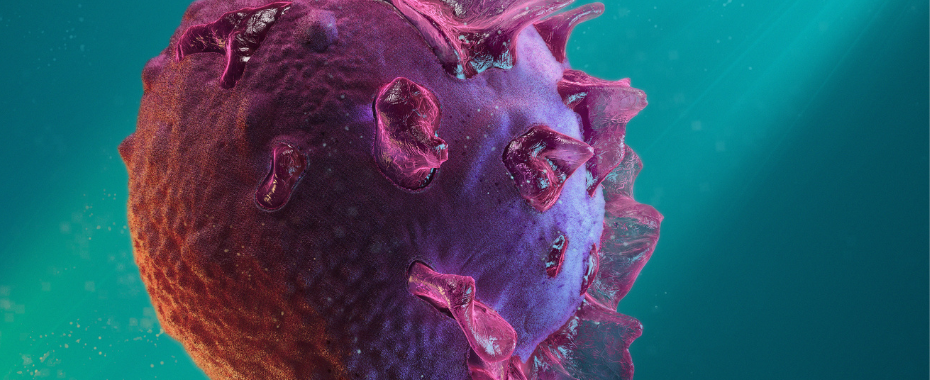In a study published in January 2023, over half of long COVID patients were found to be suffering from chronic Epstein-Barr virus (EBV) reactivation.1 What is EBV, and how can a virus become reactivated? How does that translate into symptoms and autoimmunity?
Understanding Virus Reactivation
Virtually all humans are infected with EBV by the time they reach adulthood.2 EBV infections typically occur during adolescence and can be asymptotic, mildly symptomatic or cause infectious mononucleosis, resulting in severe fatigue for several months. After the acute infection concludes, the virus manages to evade complete eradication by the immune system by hiding in human tissue. It can remain dormant in the B cells of the immune system, the larynx, or even thyroid tissue.
Epstein-Barr Virus Reactivation
If some significant immunological stressor occurs in the human host, the dormant EBV can transform into a reactivated phase, where it begins to actively replicate in the human host tissue. This infection differs from the acute phase, which occurs in the
blood. By replicating in tissue, EBV can maintain a chronic infectious state while avoiding immune surveillance and clearance. Known as chronic EBV, this reactivated viral infection has been associated with numerous autoimmune diseases, including:
- Multiple sclerosis
- Autoimmune liver disease
- Hashimoto’s thyroiditis
- Grave’s disease
- Type 1 diabetes
- Sjogren’s syndrome
- Rheumatoid arthritis
- Lupus
Other Chronic Viral Infections
Other viruses that are members of the herpes family can also enter a reactivated secondary state and cause similar immunological issues. After EBV, the second most important member of the chronic viral infection family is human herpesvirus 6 (HHV-6).3 HHV-6 causes a childhood illness known as roseola in the acute phase. When reactivated in adulthood, it is linked to chronic fatigue and a unique host of autoimmune diseases, including:
- Multiple sclerosis
- Alzheimer’s disease
- Parkinson’s disease
- Thyroid autoimmunity
- Guillain-Barré syndrome
- Sjogren’s syndrome
- Lupus
- Chronic fatigue syndrome/myalgic encephalomyelitis
How Virus Reactivation Induces Autoimmunity
Molecular mimicry is the mechanism through which a reactivated virus can induce autoimmunity. This is when the viral infection induces a robust immune response by producing IgG antibodies against various viral antigens. These antibodies have sequence homology to various human tissues, so although the antibodies initially form to assist with infection clearance, they can have the unintended consequence of binding to human tissue and contributing to autoimmunity.
Testing for Chronic Viral Infections
Given the potential contribution of chronic viral reactivation to autoimmune disease and how prevalent this may be in the general population, looking for it in the clinical setting is critical.
Polymerase chain reaction (PCR) testing depends on the presence of viral replication in the blood. Since chronic viral infections are active in tissue, PCR tests are useless in this scenario; therefore, antibody testing is used to detect chronic viral
infections.
For EBV reactivation, the following antigen tests should be ordered:4
- EBV viral capsid antigen (VCA) IgG and IgM
- EBV nuclear antigen IgG and IgM
- EBV early antigen IgG
Complications of Virus Reactivation Testing
EBV reactivation is traditionally defined by the presence of EBV early antigen IgG. The memory of prior acute infection is defined by VCA or nuclear antigen IgG antibodies. If memory antibodies are present, then alternative reactivation criteria include
the simultaneous presence of IgM antibodies to either VCA or nuclear antigen.
To further complicate testing interpretation, data suggests that extreme elevations of memory antibodies may also indicate reactivation—even in the absence of IgM antibodies or an early antigen antibody.
HHV-6 reactivation is more simply defined as the presence of IgM antibodies to HHV-6 in an adult.5
Chronic Viral Infection Treatment
Once a viral reactivation has been identified, a specific treatment plan should be built to help the immune system suppress the viral replication so that it may enter a dormant state once again. The pillars of that protocol should include:
- Mitochondrial support via mitochondrial nutrients and phospholipid replacement therapy
- Direct antiviral support with a blend of vitamin A, vitamin C, vitamin D, astragalus, elderberry, L-lysine, olive leaf extract and monolaurin
- Natural killer cell support with mushroom extracts
- IV vitamin C or ozone therapy can be a useful step if necessary
Virus clearance can be tracked with the same diagnostic antibody testing listed above, and clearance will show a resolution of the markers associated with reactivation. Antibodies will typically lag behind the actual clearance event, so plan on checking them four to six weeks after the employment of a protocol and the improvement of the clinical symptoms or autoimmune markers that prompted the investigation.

To learn more from Dr. Vojdani about chronic infections, watch his webinar, The Impact of Prolonged Infections on Immune Resilience.

Elroy Vojdani, MD is the founder of Regenera Medical, a boutique Functional Medicine practice in Los Angeles, California. Upon graduating medical school from the University of Southern California and completing his residency at USC Keck School of Medicine, Dr. Vojdani began his career as an interventional radiologist, diagnosing and treating complex, late-stage cancers and other extremely debilitating diseases. While this experience gave him unique insight into hospital-based medicine, his desire to stop disease before it reached the point of becoming a chronic illness remained at the core of his desire to practice medicine. Today, he continues in his father’s footsteps–pioneering to find answers to medical conditions that go undiagnosed and untreated.
Dr. Vojdani has co-authored more than 20 articles in the scientific literature and continues an integral role in research related to autoimmune, neurodegenerative and autoinflammatory conditions. He is also the co-author of a medical textbook, Food Associated Autoimmunity.
References
- Manoharan S, Ying LY. Epstein Barr Virus Reactivation during COVID-19 Hospitalization Significantly Increased Mortality/Death in SARS-CoV-2(+)/EBV(+) than SARS-CoV-2(+)/EBV(-) Patients: A Comparative Meta-Analysis. Int J Clin Pract. 2023;2023:1068000.
- Houen G, Trier NH. Epstein-Barr Virus and Systemic Autoimmune Diseases. Front Immunol. 2021;11:587380. Published 2021 Jan 7.
- Sultanova A, Cistjakovs M, Gravelsina S, et al. Association of active human herpesvirus-6 (HHV-6) infection with autoimmune thyroid gland diseases. Clin Microbiol Infect. 2017;23(1):50.e1-50.e5.
- Vojdani A, Vojdani E, Saidara E, Maes M. Persistent SARS-CoV-2 Infection, EBV, HHV-6 and Other Factors May Contribute to Inflammation and Autoimmunity in Long COVID. Viruses. 2023;15(2):400. Published 2023 Jan 31.
- Chen X, Li H, Wu C, Zhang Y. Epstein‒Barr virus and human herpesvirus 6 infection in patients with systemic lupus erythematosus. Virol J. 2023;20(1):29. Published 2023 Feb 12.



